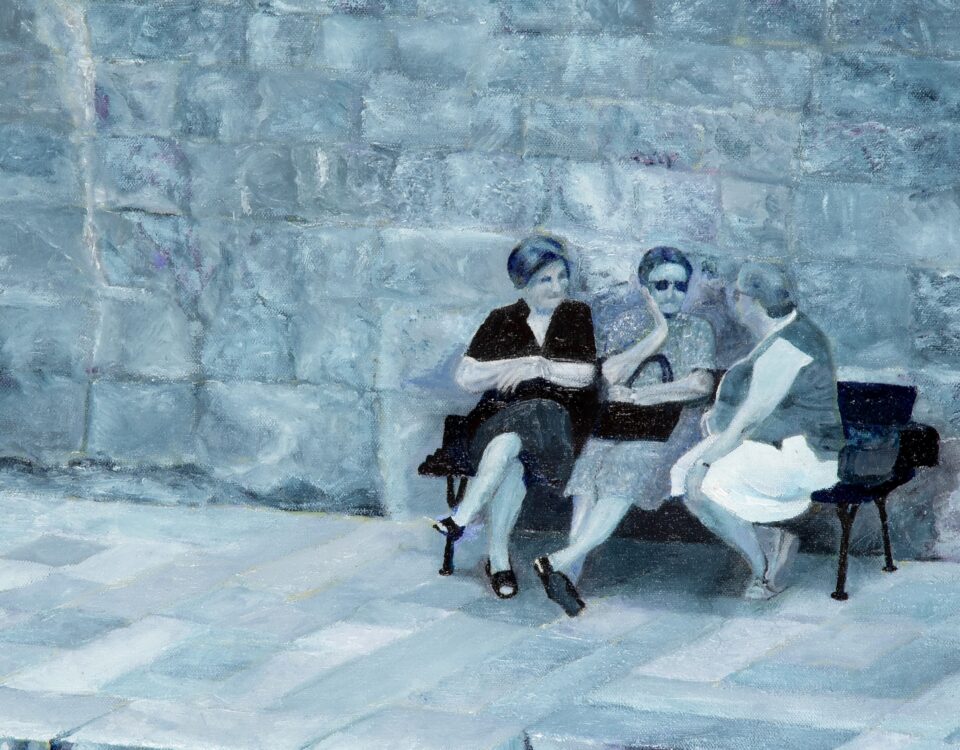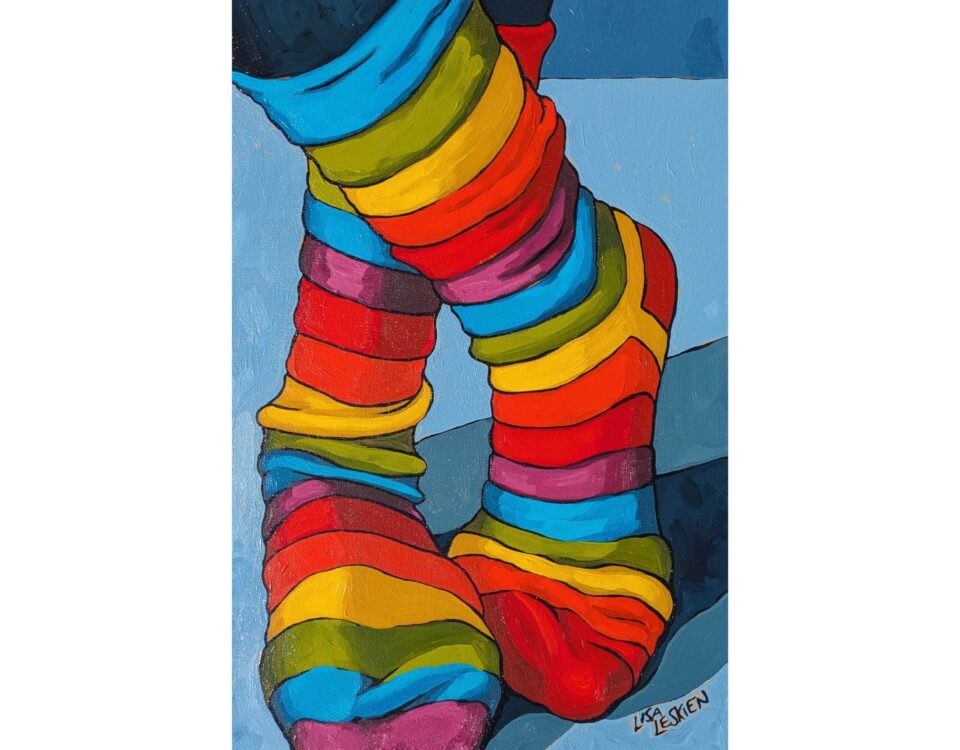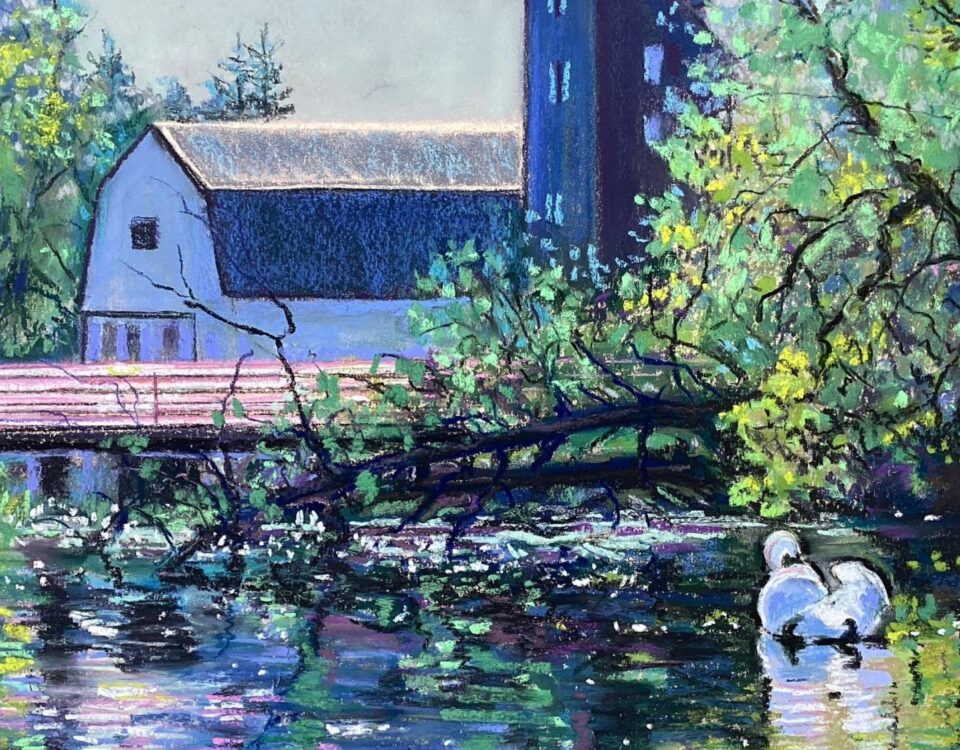
Artist Mark Algar loves to tell stories, visually through his art or chatting with friends, family and people he meets. His show Pigments and Prose opens November 7th at the Quinte Arts Council (QAC) Cultural Hub. It’s a chance to see his storytelling in action. The show runs until December 20th. Come from 4-6pm on November 7th for a chance to hear stories directly from Algar. Each painting in the show is accompanied by a paragraph of prose to share the background on the inspiring scene, or his painting process.
This show has come together over the last 18 months, with Algar painting during the week and then having consulting sessions with his art coach Susan Diehl on weekends. This show is a labour of love and dedication. Some of the stories the paintings are telling are those of people going about their daily lives, as well as stories of the nature of eastern Ontario.
“I love the mixed forests of eastern Ontario, and the wide range of colours that are experienced over the seasons. There are local scenes that I find especially stunning that I’ve included in the show,” says Algar. “The falls at Chisholm Mill’s in Roslin during a hot summer day, a painting I did as an entrant in the Quinte Plein Air Event is one. There are also two scenes from a local farm in the autumn and winter.”
Algar completed his first oil painting at age 12, and his love of art has always been a strong part of him but his career as an adult was outside the arts. He picked up fibre arts, watercolours and oil painting as a hobby. That hobby shifted into a dedicated pursuit of the arts after he retired.
“I had the opportunity to live in Paris for four years, where I enjoyed using up my seven weeks of annual vacation. Inspiring scenes throughout Europe, stunning works of art in the plentiful museums stimulated me to put brush to canvas more often,” says Algar. “I started art courses when I returned to North America, and when I retired, I took courses on painting fundamentals at the Scottsdale Artists’ School in Arizona. I found my art coach there and I continue learning from her today. I see it as a journey that will continue forever.”
Pigments and Prose is showcasing new techniques for Algar as well as an evolution of some of his earlier work that makes for interesting and dynamic visual storytelling.
“My work has always been realistic oil paintings of scenes that I have witnessed with my own eyes. I take extreme care to perfect the composition before applying pigment to canvas,” says Algar. “As for new techniques, there is one scene of three women on the quay in old Dubrovnik that was done in tones of one colour only, and another painting done in the Japanese notan style, with four gradients from dark to light of the same base colour. These are new techniques for me.”
Algar finds an emotional connection with the scenes in his paintings. He typically paints the scenes as he has seen them, although occasionally he will “let his imagination soar” and add in small details but he likes when he’s able to capture things as they happened.
“Usually I paint the scene as it initially inspired me, the dog pulling at the leash as his owners got too close to the edge of Miles Canyon, my camera ready at the perfect instant. Or the young workers jumping in the water at Chisholm Mill to cool off before they returned to finish putting on the new roof they were working on,” says Algar. “The humbleness of humans as they interact with nature, knowing that they are happy and refreshed for having stopped for a moment, but perhaps wondering why. I want to paint the why.”
The selection of paintings at Pigments and Prose offers something for everyone. Younger viewers may delight in searching for all the hidden figures in Lone Tree or imagining themselves as the young girl assisting with the painting. Romantics will be drawn to the scene of the bridge in Lamballe, where a couple meets, while those with a family focus will appreciate the charming depiction of two boys sharing melon or the lively, multi-generational gathering at Charly’s Bar. Nature lovers, too, will find plenty to immerse themselves in among the collection’s natural beauty.
“The love and joy I’ve had every day, the hope in our small community of humans around the world, and the wonder of the beauty and power of nature are the emotional background that I want my viewers to see and feel,” says Algar.
Pigments and Prose is on display at the QAC Gallery, 36 Bridge St East, until December 20th. Opening night with an opportunity to meet the artist will take place November 7th from 4PM-6PM.
The full interview:
1. What inspired the theme or focus of your upcoming art show?
The theme “Pigments and Prose” is based on my love of painting and telling stories. Most of my art tells a story visually – chatting with friends, hunting for clams, or skipping stones on a lake, but I also send out a Saturday newsletter describing one of my tours, or my approach to completing a specific painting, and some of these are illustrated with my creations. At the show, each painting will have a paragraph of prose to share the background on the inspiring scene, or my painting process.
2. How do the pieces in this show differ from or build upon your previous work?
I began painting on larger canvases about two years ago, up to 3’ x 4’, or 91 cm x 122 cm. I’ve also continued sessions with my art coach Susan Diehl over this period. The result of more spacious canvases and teachings I’ve received have greatly improved the impact of my paintings.
3. Can you share the process behind selecting the pieces that will be featured in the show?
I’ve selected what I consider my best work. I’ve chosen my paintings that tell stories, those with people going about their daily activity.
4. What role does the local landscape of Quinte play in your art, and how is that reflected in this collection?
I love the mixed forests of eastern Ontario, and the wide range of colors that are experienced over the seasons. There are local scenes that I find especially stunning that I’ve included in the show. The falls at Chisholm Mill’s in Roslin during a hot summer day, a painting I did as an entrant in the Quinte Plein Air Event is one. There are also two scenes from a local farm in the autumn and winter. A fourth painting of the autumn colors on my street in Belleville is still in progress and will have to be in my next show.
5. How long did it take to create this show?
Over the last 18 months I have painted on most weekdays, while having consulting sessions with my art coach on the weekends. Additionally, I have spent a few weeks travelling to create photographs of stunning scenes for future creations.
6. What is your artistic background/education?
I completed my first oil painting of my favourite birch tree when I was 12. However, my career focused elsewhere, and my experience with fiber arts, watercolors and finally oil painting was only a hobby. This changed when I had the opportunity to live in Paris for four years, where I enjoyed using up my seven weeks of annual vacation. Inspiring scenes throughout Europe, stunning works of art in the plentiful museums stimulated me to put brush to canvas more often. I started art courses when I returned to North America, and when I retired, I took courses on painting fundamentals at the Scottsdale Artists’ School in Arizona. I found my art coach there and I continue learning from her today. I see it as journey that will continue forever.
7. How did you develop your love of art?
I don’t remember my love of art developing. It was just there, a strong part of me as I grew up. Perhaps it started early through experiencing the beauty of nature, or the attraction of original oil paintings hanging on the walls of my home, or in the museums we toured. I remember being captivated by the Night Watch by Rembrandt, and the Mona Lisa when we toured Europe when I was 12. That surely helped.
8. What techniques or materials are you using in this collection, and have they evolved from your earlier work?
My work has always been realistic oil paintings of scenes that I have witnessed with my own eyes. I take extreme care to perfect the composition before applying pigment to canvas. As for new techniques, there is one scene of three woman on the quay in old Dubrovnik that was done in tones of one color only, and another painting done in the Japanese notan style, with four gradients from dark to light of the same base color. These are new techniques for me.
9. Are there any experimental elements in your work for this show that viewers might not expect?
Viewers who know me might be surprised by the larger canvas sizes, and the two new techniques mentioned above.
10. Can you walk us through your creative process for one of the key pieces in the exhibit?
I’ll use the Auray Harbour scene for this purpose, as there were several twists and turns as it took shape. It was serendipity that we found the scene at all, my art coach looking out the car window as we travelled along a highway in Brittany, France and calling out “what is that?” We took an unplanned detour and found this lovely old harbor where Benjamin Franklin first stepped on French soil. Everywhere I turned was a great scenes, and I captured good photos for when I returned to the studio. I wanted to include both the old storefronts and the boats on the river in my composition, but this created a problem with what began to look like two different paintings. Therefore, I adjusted the color of the boats to closely resemble the buildings, pulling them together visually. I adjusted the tree line in the distance so it didn’t look like an arrow pointing to the middle of the work. Adding people in carefully chosen spots created a path into the painting. The final step was adjusting the perspective and size of the sunken boat launch to allow the viewers eyes to more comfortable trace the activity of the harbor front.
11. Is there a personal or emotional story behind the creation of this body of work?
Each of the paintings here resulted from an emotional connection as I walked through the scene, each of them experienced by me personally with family or friends. Sometimes I let my imagination soar, for instance adding the couple on the stone bridge in Lamballe, France. But usually I paint the scene as it initially inspired me, the dog pulling at the leash as his owners got too close to the edge of Miles Canyon, my camera ready at the perfect instant. Or the young workers jumping in the water at Chisholm Mill to cool off before they returned to finish putting on the new roof they were working on. The humbleness of humans as they interact with nature, knowing that they are happy and refreshed for having stopped for a moment, but perhaps wondering why. I want to paint the why.
12. How do you feel your art communicates with viewers, and what do you hope people take away from this show?
I sold my very first painting to a person visiting from Norway, who said it evoked in him a strong memory of his grandfather getting food from his backyard cold storage buried under a hill of earth. I hope that each viewer who comes into the gallery finds a painting that speaks so strongly to them, and that they pause to enjoy the moment.
13. Have recent global or local events influenced your art in any significant way?
I enjoy the strength of old buildings and bridges, the comfort of families meeting together, and the massive size of quiet mountains. So generally not. I thought the lower lake level of Kluane Lake in the Yukon was showing the impact of global warming, but research after visiting the scene corrected me on the reason for the change.
14. What message or mood do you hope resonates with the audience when they experience your work in this exhibition?
Firstly, I would like my audience to be happy, perhaps pleasantly surprised at something they find in one of the scenes or warmed by a past memory that my painting has reminded them of. It would be wonderful if one of the viewers broke out in laughter in front of one! Some artists have had disturbing, frightful experiences, and they paint those because for them it evokes the strongest emotion. For me, the love and joy I’ve had every day, the hope in our small community of humans around the world, and the wonder of the beauty and power of nature are the emotional background that I want my viewers to see and feel.
15. Have you tailored your show to a particular audience, or do you aim for a more universal appeal?
I hope that the set of paintings I’ve chosen have something for everyone. The younger viewers may enjoy searching for all the people in “Lone Tree,” or put themselves in the shoes of the young girl helping me paint. The romantics will probably love the bridge in Lamballe and the couple meeting there. The family- oriented will probably love the two boys eating melon, or the crowded multi- generational scene at Charly’s Bar. And the nature lovers? There is lots for them to soak in.
16. How do you feel about the interaction between your work and the gallery space it will be displayed in?
The gallery space is so flexible that I had a blank canvas with which to stage my show. The walls disappear into the background, the light flows in the front window, at least during the day on sunny days. But the best part of the gallery are the people who work there and make the life of artists uncomplicated and fun.
17. As a Quinte-based artist, how has the local art scene influenced your creative development or approach?
My participation in the Quinte Plein Air event has allowed me to grow in several different directions – the confidence and speed of concluding on a composition, the marriage of colors across the scene, and the specific, helpful feedback from the judges at these annual events. I also enjoy meeting and seeing the work of local established and developing artists in the art walks, studio tours and galleries that are nearby. I am painting better and more confidently because of this environment.
18. What role do you think art plays in bringing people together, especially in regional communities like Quinte?
To see complete strangers share their thoughts about a painting is very rewarding. A strong, well executed work encourages people to first feel, then share. The speed painting challenge that takes place on Front Street in Belleville during the Quinte Plein Air event brings hundreds of people together as individuals, families or friends to enjoy the making of new art.
19. Why do so many artists flock to PEC and the Quinte Region?
I spoke to an artist who lives west of Toronto and asked him why he came to paint in Quinte and PEC. He responded that this area has everything: boats, rivers, forests, old buildings, marshes and lakes, trains, crowds young and old, and bright skies which bring out the best colors when the sun is shining, which it very often does. And a very supportive community for all artists. It's just the perfect place to bring an empty canvas and fill it with a slice of what can be found here.
20. What’s next for you?
I would like to find a place where I can permanently display my paintings. My studio is not bad, but only I see what’s there. I would like to interact more completely and regularly with everyone who appreciates art, from nearby and from far. I would also like to improve my painting skills, an objective that I will have forever. I start a new course of instruction and coaching this month.


